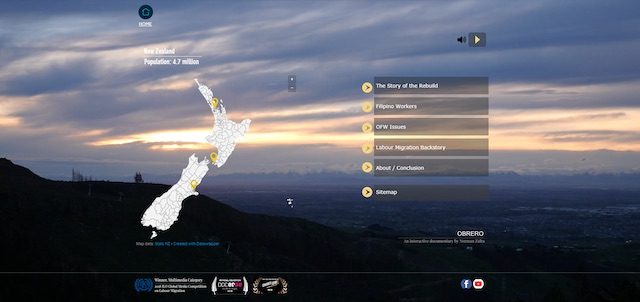SUMMARY
This is AI generated summarization, which may have errors. For context, always refer to the full article.
![[OPINION] The new documentary film and its role in democracy](https://www.rappler.com/tachyon/r3-assets/612F469A6EA84F6BAE882D2B94A4B421/img/5577AEAFBECC4FD3BDFD89EE1078B262/imho-filipino-digital-films.jpg)
I unveiled, for the first time, my interactive documentary (i-doc) titled Obrero to a roomful of overseas Filipino workers (OFW) in New Zealand. The i-doc forms part of my multiplatform documentary that tells the story of Filipino rebuild workers migrating to Christchurch after the 2011 earthquake.
Rushing to describe and define what an i-doc was, I told my audience, “It looks like a website, but it feels like a film.” I then spent the next couple of minutes showing fragments of my i-doc and uncovering the documentary contents hiding beyond its interface.

At that point, it seemed like my i-doc had finally met its first audience. Given the bottlenecks faced by filmmakers in reaching their audience, can the i-docs’ unconventional means of storytelling flourish as a documentary format in the Philippines?
Filipino docu origins
Documentary as an art form and a genre is historically marginalised by cinema’s commercial imperative. Thanks to the renewal of political documentaries in the recent past (e.g. Michael Moore’s Fahrenheit 9/11 in 2004 and Al Gore’s An Inconvenient Truth and its sequel in 2006/2017), audiences have revived their interest in documentaries as an alternative means of understanding the world.
The success of local films such as Baby Ruth Villarama’s Sunday Beauty Queen (2016), Sheron Dayoc’s The Crescent Rising (2015), and many other award-winning documentaries has signaled a dashing hope among struggling independent documentary makers trying to find their place in a shrinking industry.
Filipinos’ appreciation of the documentary can be attributed to the popularity of public affairs news magazine programs aired by commercial media giants in the country. The Probe Team, led by Cheche Lazaro, was one of the early adopters.
As an independent outfit, Probe had no permanent home, and it was able to move from one station to another while maintaining its identity and branding. Its model of distribution is called block timing or brokered programming, in which network owners sell airtime to independent producers.
Soon after, television companies began forming in-house production teams creating home-grown rather than outsourced documentary content. Due to the broader reach of television, Filipinos today commonly associate the documentary genre with the news magazine format often hosted by a journalist or a personality and akin to long-form news reporting.
But the documentary genre had reached Philippine soil long before Probe. In 1917, Jose Nepomuceno and his brother Jesus started producing newsreels for American film studios through their independent production house Malayan Movies. A newsreel is motion picture news footage showing current events, personalities, and other topics of interest, and is considered an earlier variant of the documentary.
We didn’t have a precise notion of documentary film then as the genre was still emerging in countries such as Britain and the Soviet Union.
Many years after, Filipinos rekindled their interest in ‘third cinema’ filmmaking through Kidlat Tahimik’s first-person radical films.
His most popular film, Mababangong Bangungot (Perfumed Nightmare, 1977), a mixture of fable, biography, documentary, and avant-garde, challenged Filipino colonial mentality and resisted the dominance of Western influence on our local culture. Many international critics celebrated it as a refreshing film practice combining politics and aesthetics.
Despite accolades and acclaim overseas, independent documentaries outside television circuits are relatively unknown to the Filipino mass audience. Today, our local talents are combing festivals and pitching fora overseas in search of funding and distribution opportunities.
A few initiatives in the Philippines that support filmmakers through production grants have emerged in recent years, such as the SineSaysay Documentary Film Lab and festival venues such as QCinema and Active Vista, among others. We still have a long way to go before we elevate independent documentary culture in the country, but these platforms contribute to the re-emergence of documentary in the Filipino public sphere.
Interactive documentaries
Given my shoestring budget, my independently produced i-doc offers only basic graphics, interface and moving images. But a web documentary can reach an audience outside the festival circuit and can enjoy an expanded lifespan online.
It can also effectively represent, explain, and humanize a complex political and cross-border issue. As a result, we see a new breed of filmmakers who now collaborate with multimedia artists, web designers, and computer coders in crafting a new mode of documentary storytelling.
Although a distinct form of media, i-docs retain the purposes of conventional documentaries – to persuade, record, educate, and provoke social change. Scholar Michael Renov labels these purposes as ‘modalities of desire.’ This means that i-docs also investigate social dilemmas (e.g. Journey to the End of the Coal, 2009), promote a social cause (e.g. The Big Issue, 2009), depict a slice of reality (e.g. Out My Window, 2010), or represent the voiceless in society (e.g. The Quipu Project, 2014).
Because the field is open for experimentation, i-docs’ style and aesthetics vary from one to another. Some i-docs are game-like and immersive while others allow the audience to play a role while navigating the story. Unlike a traditional film with a beginning, middle, and end, i-docs are non-linear and flexible, giving users more control in content navigation.
Critics say that giving the audience too much control in navigating a web platform is detrimental to story coherence. Others raise technical limitations, poor retention, and the need for higher bandwidth to successfully interact with web-based media.
Indeed, these are legitimate concerns that highlight the vulnerability of i-docs as a sustainable documentary format. But we have always been skeptical about emerging forms of media practice. Practitioners didn’t take Facebook seriously when it was born in 2004 or YouTube in 2005. And we initially looked down on new media as a platform for serious journalism until it became too popular and influential to be ignored.
Funding is of course a constant impediment. As expected, Western countries such as Canada, UK, and the USA, with established institutional funding for film production, are steering many experiments in innovative types of storytelling. But the Philippines’ local talents can definitely keep up.
Conventional documentaries are here to stay, and i-doc is meant to complement and not to compete against established norms. Whatever format, style, and fashion, the documentary assumes an important role in a democracy. It addresses you not as an individual but as a citizen in our society.
This is an opportune time for Filipino creative practitioners to experiment on new platforms and for film-funding entities to give i-docs a try. Given the limited exhibition opportunities for independent documentaries in the Philippines, the open distribution model of i-docs could flourish in a fast-changing media environment.
After all, what digitization affords us is an equal playing field – amateurs and experienced filmmakers, from rich and developing countries, can now engage new audiences and represent social reality in ways unimaginable before. – Rappler.com
Norman Zafra is a Filipino documentary maker and currently a doctoral candidate in media and communication at the University of Auckland. You can experience his i-doc here.
Add a comment
How does this make you feel?





There are no comments yet. Add your comment to start the conversation.